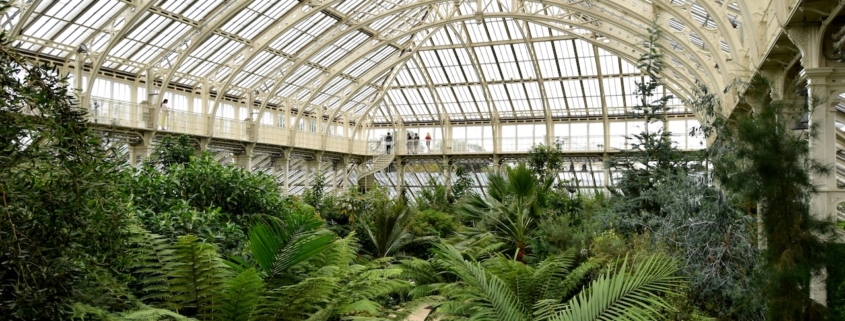New Aluminium Greenhouses at Kew
Summer means time in the garden, and those of you with green fingers may be in daily contact with aluminium extrusions. Whether you call it a glasshouse, orangery or hot house, the place where your plants are protected from the elements is likely an aluminium greenhouse.
The desire to grow species that are not native to our climate dates back to the 17th Century, when neither glass nor aluminium were widely available. However, the promise of exotic tastes, including oranges, pineapples, grapes and nectarines, drove innovation. Early constructions were formed from wood, then iron and steel. However, aluminium greenhouses are now commonplace, and it has been used for the huge installations at Kew Gardens.
All Change at Kew
All change at Kew. England’s first botanical garden has announced the renovations of one of its largest attractions, The Palm House. Although a temporary measure, the plans to upgrade the gas boilers with air and water heat pumps will see the Palm House close for 5 years. When the plants have been removed, rust will be cleaned from the wrought iron metalwork, and the frame will be repainted.
In 1848, when the original Palm House was opened, it was one of the first large constructions in wrought iron and glass. The design was innovative and spectacular. However, the humid conditions required to grow the exotic plants took their toll on the metalwork. By the 1980s, sections of iron had to be replaced with steel. Once again, the ironwork is showing considerable signs of corrosion and needs repair. In addition, climate controls are to be upgraded to optimise energy efficiency.
Two Aluminium Glasshouses at Kew
Relocating all of the plants from the Palm House is a mammoth operation. Two state-of-the-art greenhouses have been erected to make it possible. The first is the new Propagation House. This permanent feature will enable Kew Gardens’ continuing role in global plant conservation and research.
Then, there’s the Decant House, an aluminium and glass Vento-style super structure, measuring 384m². It will be the temporary home to the mature plants being removed from the Palm House. Although this won’t be open to the public, visitors will be able to view the impressive plant collection through the glass panels.
The two new glasshouse structures are constructed from strong, yet lightweight, aluminium extrusions. This is now the material of choice for modern commercial and residential greenhouses. Unlike iron, aluminium is resilient to the moist, warm conditions inside, as well as outdoor weather conditions. As such, the structure won’t rust and offers a low-maintenance solution.
Sustainable Growth
Early glasshouses used a variety of underfloor heating systems, along with natural sunlight, to keep the environment warm. Only the most wealthy could afford to run these ‘hot houses’ and cultivate curious plants, flowers and fruits collected by Victorian adventurers. Therefore, glasshouses and the technology used to heat them were a sign of status and intrigue.
In modern constructions, advancing technology continues to play a vital role in greenhouse design. Contemporary commercial greenhouses enable growers to increase crop yields while reducing energy costs. Sustainability is crucial to the future of food production. Net Zero is the goal for the Palm House restoration, and it is a driver of horticultural innovation for growing sufficient food to meet demand.
Sustainability is another reason why aluminium is a metal of choice for contemporary greenhouses, because it is an infinitely recyclable material. The framework is likely formed from a high percentage of recycled aluminium and, if the greenhouse is dismantled, it can be recycled again. Equally, the metal is sufficiently strong to support renewables, such as solar panels.
UK Manufactured Aluminium & Glass Greenhouses
It wasn’t that long ago that the majority of greenhouse frames were manufactured and assembled in the UK from aluminium extrusions. However, many firms switched to cheaper suppliers in China for mass-produced greenhouses.
Specialist manufacturers still custom-design and build commercial and specialist greenhouses, which are manufactured from aluminium extrusions in the UK. These include Cambridge HOK, the company selected to design, manufacture and install the new aluminium glasshouses at Kew Gardens. Cultivar Greenhouses and Alitex both promote the benefits of aluminium in their custom designs. Their greenhouses are installed in National Trust properties and other prestigious venues.
Specialists in the Design of Aluminium Extrusions
Salesmade Ltd specialise in the design, fabrication, finish and assembly of aluminium extrusions. We manufacture untreated and powder-coated frameworks for a wide range of external applications, including window frames, frames for solar panels and sports equipment.
With a fully equipped on-site facility in Buckinghamshire, we are committed to sustainable production. It’s not just aluminium that’s recycled. For example, we have systems to reuse heat and water generated in the factory. What’s more, we champion UK production to avoid the carbon emissions generated by shipping parts from overseas.
So, if your company is seeking a sustainable supply chain as part of a commitment to Net Zero, contact us to discuss your aluminium extrusion needs. From hot houses to heat sinks, we design custom solutions to match your requirements.
—
Photo credits to Tamás Lichter



